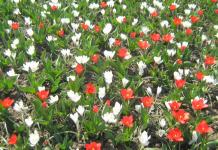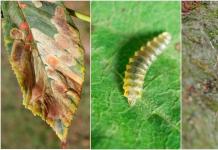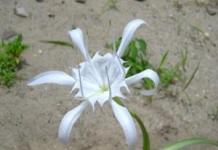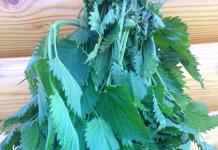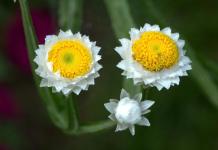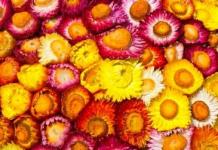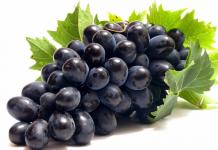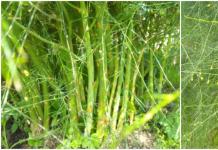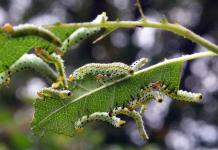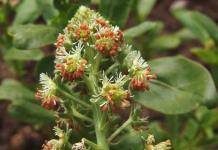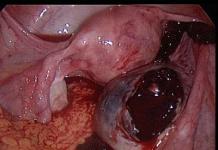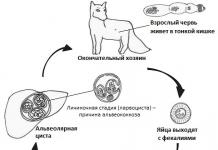Habitats in nature are unknown. Although there is an assumption that the Schubert barb is found in the rivers and streams of South Asia. At the same time, it is believed that the Schubert barbus is a selective form of the green barbus. This fish got its name in honor of the American Tom Schubert, who first described it.
The Schubert barb was introduced to Russia in 1956 and since that time is often found in home aquariums.
The size
Schubert's barbs grow up to 5-7 centimeters in length.
Color
The body of the fish is shiny yellow. The color can take on various shades from golden to reddish yellow. On the side there is a greenish longitudinal stripe with black spots. The female may have no black spots on the side. The belly of Schubert's barbus is silver in the female and red in the male. The fins of these fish are also red. At the base of the caudal fin there is black spot... There are several spots of the same color on the dorsal fin. Males are brighter than females.
Body shape
The body of the Schubert barbus is dense and slightly flattened on the sides. The eyes are large. There is one pair of antennae on the head. The tail is two-bladed. The female is larger than the male and her abdomen is thicker.
Barbus Schubert is an active schooling fish. It is better to keep 8-10 individuals at once. They have a very peaceful character, so they get along well with other peaceful fish. However, if they do not have enough food, they can nibble on the large fins of their neighbors, for example, veil-tails. They keep in the lower layer of water.
Requirements
The water temperature is 19 - 24, the hardness and acidity do not really matter, but if you wish, you can maintain the hardness from 4 to 16 degrees, pH 6.5 - 7.0. Because of a large number secretions from these fish require filtration, aeration and replacement of a fifth of the water every week.
Schubert's barbs are unpretentious in food. They can eat both live and plant food. Food is caught in the water or collected at the bottom of the aquarium. They do not tend to take food from the surface.
Breeding
Schubert's barbs reach sexual maturity at 8 - 11 months. It is believed that these fish are very easy to breed. Before spawning, females and males should be kept separate for 7-10 days and very well fed. Males need to be given only live food, and females live with the addition of vegetable.
The stimulus for spawning is the replacement of some of the old water with fresh water and a rise in temperature by a couple of degrees. The length of the spawning box for one pair must be at least 60 centimeters. In the evening, producers are released into the spawning grounds, and in the morning spawning begins. The female lays 200 - 300 eggs. After spawning, for the safety of the fry, the producers are sown. If spawning occurs in common aquarium, eggs can become a "victim" of both the parents themselves and their neighbors. The incubation period is 1-2 days. On the third day, fry appear. The initial food is "live dust".
Schubert's barbs live 3-4 years.
Maria Yaskevich,
specially for
A beautiful, bright and very active fish, the Schubert barbus, conquered many aquarists with its cheerful, mobile disposition. But in addition to its unique interesting color and its inherent peacefulness, it is an extraordinary species among its aquarium counterparts, since it does not occur in nature at all. In other words, this variety was developed under artificial conditions by the American T. Schubert. And it is considered an ideal option for novice aquarists, but in the aquariums of true professionals, it can take pride of place.
Quick jump to the article
Description
Schubert's barbus has a rich bright color, which varies from yellow-lemon color to yellow-red, but most often individuals with yellow-orange scales are found. As a rule, the bright shades of the barbus are covered with a greenish strip and black spots, but the females do not have such interesting color elements at all. The base of the tail is also covered with black specks of various sizes, and the fins have a delicate pinkish tint. Sometimes you can find barbs of bright red color, but there are very few such specimens.

The body is slightly flattened at the sides, dense and elongated in length. The tail is two-lobed, the mouth is lower or terminal, the eyes are large enough in relation to small size torso and a pair of small antennae. Barbs live in an aquarium for no more than 4 years, grow up to 7 cm in length. They are friendly enough that it makes it possible to keep them with other peace-loving fish in the same aquarium.
Habitat conditions
Barbus Schubert is very fond of communication, which is why it must be kept in a small flock of 8 or 10 individuals. In addition, being in flocks, they are more active, less prone to stressful situations and interesting in behavior. But in order for the barbs to feel good, they need large aquarium designed for 70 and 100 liters. Densely planted with all sorts of aquarium plants and well lit, especially in the open area of the aquarium. It is in this part that Schubert's barb likes to swim calmly in a flock.
See a flock of Schubert's golden Brabus.
- Water temperature 19 - 24 ° C
- Change the water weekly, about 20% of the total
- Do not forget that water filtration and aeration are one of the main conditions for the full development of fish.
- It is better to choose aquarium plants small size and preferably shade-tolerant, such as anubias or cryptocorynes. The soil should be kept in dark colors, granite chips are perfect
- Red neons, rhodostomuses, thorns and other peaceful species will be ideal neighbors for the barb aquarium. But it is undesirable to settle these fish with veiled-tailed species, as they may be left without their delicate fins.
- Not picky barbus Schubert and food. You can feed them with absolutely any food: combined dry formulations, bloodworms, tubifex, lettuce, cabbage and small-leaved algae. But it is worth noting that even a small curd can be ideal for an extraordinary snack.
But adult barbs and dorado in one aquarium.
Breeding
Reproduction of this species is perhaps one of the easiest fish to breed. The barbus becomes sexually mature by 8-10 months. Around a week before spawning, aquarists recommend placing the breeders in a separate aquarium and not forgetting about frequent feeding. The spawning aquarium must also be properly prepared. Place small-leaved plants or a separator net on the bottom.
After the spawning of the fish, the producers must be deposited by adding approximately 20% water to the aquarium. Already after the third day, the fry after birth begin to swim, and on the fourth day they eat. Live dust, ciliates and nauplii are suitable as food. Over time, the amount of feed should be increased, and matured individuals should be transplanted into a more spacious container and transferred to standard feed.

Thus, the Schubert barb is very easy to maintain and breed. In particular, even water treatment for spawning consists only in settling water and adjusting the temperature to certain parameters. And in order to create ideal living conditions for active and funny barbs, in an aquarium, it is necessary to add to clean water some live plants, dark soil, some driftwood and overhead lighting. As a result of such simple actions, active and funny barbs will delight their owner constantly.
The fish, which appeared in Russia just over fifty years ago, got their name from the person who first described them - Tom Schubert. Barbus Schubert is a small but cute, peaceful and mobile fish that loves to live in a flock. Therefore, Schubert barbs should be kept in an amount of at least 8 individuals.
Barbus Schubert - content
Barbus Schubert is not particularly picky and belongs to the category of fish that even beginners in this matter can handle. The most important thing for these barbs is that the aquarium is at least 50 liters for a couple and preferably elongated (they need room for movement). Optimal temperature regime is from 18 to 23 ° C, but, they say, in natural conditions they can survive and 10 ° C. It is imperative to provide for filtration and aeration. Changes with fresh settled water should be done once a week in the amount of 1/5 of the total volume of water. Plants, for an aquarium with Schubert barbs, are selected low and capable of withstanding a lack of light. This is due to the fact that fish of this species look best in bodies of water with a moderately lit front wall and a darkened back.
You can feed the barbus Schubert with any food: live (tubifex or bloodworm), vegetable (it can be small-leaved algae, or chopped cabbage or lettuce leaves), as well as dry or combined. In addition, Schubert's barbus can be fed with grated cottage cheese.
It is permissible to add any other non-aggressive fish to an aquarium with Schubert barbs. But you should be very careful with veil-tails, because barbs tend to pull out their fins.
Barbus Schubert: breeding
Breeding these fish is as easy as shelling pears. Barbus Schubert reaches puberty at 8-10 months. Somewhere one week before the expected start of spawning of Schubert's barbs, producers should be planted in separate reservoirs and not very abundantly, but variously fed. Spawning grounds should be provided for at least 30-50 liters of elongated shape. At the bottom of the aquarium, a separator net or plants with small leaves are laid out. Due to the fact that parents can easily eat their own eggs, considering them to be food, the thickness of the water layer in the spawning ground should not exceed 8-10 cm. This is necessary so that the eggs have time to fly to the bottom and "hide" under the net or leaves. The water in the spawning ground should be 25-28 ° C and always fresh (of course, settled), as this is an additional stimulus for reproduction.
After the necessary conditions are created in the aquarium, a male and a female are planted there in the evening. And the very next day in the morning, the breeding of Schubert's barbs begins, which lasts several hours. A female can lay about two hundred eggs at a time. After the end of the procedure, adult fish from the spawning grounds should be removed and replaced with 20% of water for fresh, appropriate temperature.  The incubation period for fry is approximately one day. And after the fry begin to swim, they should be fed. Dry mixture, ciliates or nauplii of crustaceans, crushed into dust, can become food for them. As the fry grow, the size of the food, as well as the size of the aquarium, will need to be increased. And the Schubert barb can grow up to 10 cm in length, although this is in natural conditions, and in an aquarium these fish reach only 7 cm. The average life span of this species of fish is from 3 to 4 years.
The incubation period for fry is approximately one day. And after the fry begin to swim, they should be fed. Dry mixture, ciliates or nauplii of crustaceans, crushed into dust, can become food for them. As the fry grow, the size of the food, as well as the size of the aquarium, will need to be increased. And the Schubert barb can grow up to 10 cm in length, although this is in natural conditions, and in an aquarium these fish reach only 7 cm. The average life span of this species of fish is from 3 to 4 years.
So when you follow the not the most difficult of the above rules, aquarium fish Schubert's barbus will certainly delight its owner, and will not cause much trouble.
Barbus Schubert (lat. Barbus semifasciolatus `schuberti`) is a beautiful and active fish, the behavior of which is typical for barbs. Its content is quite simple, but there are important details that we will discuss in the article. It is important to keep him in a flock, as this corresponds to how they live in nature. And keeping in a flock significantly reduces their aggressiveness.
Living in nature
The barbus is native to China, it is also found in Taiwan, Vietnam, in the world it is also called the Chinese barbus. The golden form is very popular, but it has been bred. artificially, by Thomas Schubert in 1960, after whom the barbus was named. Natural color is more greenish, without a wonderful golden color. At the moment, in the aquarium industry, it practically does not occur, being completely supplanted by artificially bred.
In nature, the Chinese barb lives in rivers and lakes, at temperatures of about 18 - 24 ° C. It feeds in the upper layers of water, rarely swimming to depths of more than 5 meters.
Description
The natural color of Schubert's barbus is greenish, but now it is practically not found in aquariums. Almost all fish are bred artificially, and extremely small quantities are imported from nature.
Upon reaching maturity, the Schubert barbus develops a small mustache at the corners of the mouth. The color of the fish is golden yellow, with black stripes and dots randomly scattered over the body. The fins are red, the caudal fin is bifurcated.
They grow up to 7 cm in size, and the life expectancy can be about 5 years.

Compatibility with other fish
Like all barbs, Schubert is exclusively schooling fish. You need to keep them from 6 pieces, since with a smaller amount they are stressed, lose activity and spend more time at the bottom of the aquarium. Besides, this flock looks very good.
You can keep such a school with most active and non-small fish. There are reviews from the owners that the barbs they behaved aggressively, cut off the fins of their neighbors. Apparently this is due to the fact that the fish were kept in small numbers, and they could not form a school. It is in the school that they create their own hierarchy, forcing them to pay less attention to other fish.
But, since the Schubert barb is an active and fast fish, it is better not to keep it with slow and veiled fish. For example with cockerels, or. Good neighbors will be:, and other fish similar to them.
Large invertebrates, for example, shrimps live quietly with them, but they can eat small ones.
Difficulty in content
Well suited for a large number of aquariums and can even be kept by beginners. They tolerate a change of residence well, without losing their appetite and activity. However, the aquarium with Schubert barbs should have clean and well aerated water. And it is not possible to keep it with all fish, for example, goldfish will be provided with enduring stress.
Barbus Schubert should always be kept in a flock of at least 6 individuals. So they are much more active, interesting in behavior and less prone to stress.
Since this is a rather small fish (about 7 cm), but living in a flock, the volume of the aquarium for keeping the Schubert barbus is from 70 liters, and better more.
Since they are very active, they need a lot for life. free space... Like all barbs, Schubert loves the flow and fresh water, rich in oxygen. A good filter, regular changes and moderate flow are highly desirable. They are undemanding to water parameters, they can live in very different conditions... However, the ideal would be: temperature (18-24 C), pH: 6.0 - 8.0, dH: 5 - 19.
Feeding
In nature, it feeds on various insects, their larvae, worms, plants and detritus. In other words, this is an excellent example of unpretentious feeding. To keep the health of your fish at a high level, simply diversify your diet: artificial feed, frozen, live. You can also give slices of cucumbers, zucchini, spinach, just boil them first.
Sex differences
The females of Schubert's barbus are much paler in color and with a rounded and full abdomen. In addition, they are slightly larger than males. Males are smaller, more brightly colored, during spawning their fins turn bright red. In general, sexually mature fish are not difficult to distinguish. 
Breeding
It is quite simple to breed Barbus Schubert, it often spawns even in a common aquarium, but for successful breeding, a separate spawning grounds are still needed. There must be a decent amount of small-leaved plants in it, for example, Javanese moss is good. Or, they can be replaced by nylon thread, tangled like a washcloth. Regardless of your choice, make sure that there are shelters for the female in the spawning grounds, as the male becomes very aggressive and can kill her. The lighting is dim, floating plants can be put on the surface. The use of a filter is optional, but it is advisable, most importantly, set the power to minimum.
Water parameters: soft, about 8 dGH, with a pH between 6 and 7.
Reproduction can take place both in a flock and in a pair. If you choose a flock, then the chance of successful spawning increases, and then you need to take about 6 fish of both sexes. Choose the fullest female and the brightest colored male and put them in the spawning grounds in the late afternoon. Pre-feed them abundantly with live food for a week.
As a rule, spawning begins early in the morning, at dawn. The male begins to swim around the female, forcing him to swim to the place where he chose a place for breeding. As soon as the female is ready, she lays 100-200 eggs, which the male fertilizes. Immediately after that, the fish can be planted, since the parents can eat the eggs.
The pale yellow eggs hatch in about 48 hours, and for a few more days the larva will consume the contents of its yolk sac. As soon as the fry swim, they can be fed with ciliates, artificial food for fry,. Since eggs and fry are very sensitive to direct sunlight, keep the aquarium in semi-darkness for several weeks after spawning.
Jun 15, 2014 admin


